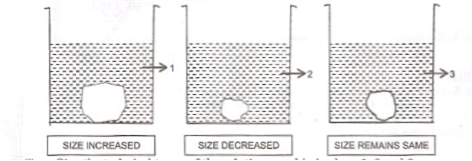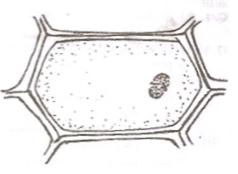For Daily Free Study Material Join wiredfaculty
Home > Absorption By Roots - The Process Involved
Absorption By Roots - The Process Involved
Match the items in column I with those in column II
| A. Xylem | (i) Semi-permeable |
| B. Phloem | (ii) permeable |
| C. Cell membrane | (iii) downward flow of sap |
| D. Root pressure | (iv) upward flow of water |
| E. Cell wall | (v) Guttation |
A. Xylem | (i) upward flow of water |
B. Phloem | (ii) downward flow of sap |
C. Cell membrane | (iii) Semi-permeable |
D. Root pressure | (iv) Guttation |
E. Cell wall | (v) permeable |
Some More Questions From Absorption By Roots - The Process Involved Chapter
A. An apparatus as shown below was set-up to investigate a physiological process in plants. The setup was kept in sunlight for two hours. Droplets of water were then seen inside the bell jar. Answer the questions that follows:
i. Name the process being studied.
ii. Explain the process named above in Q 3 a i.
iii. Why was the pot covered with a plastic sheet?
iv. Suggest a suitable control for this experiment.
v. Mention two ways in which this process is beneficial to plant.
vi . List three adaptations in plants to reduce the above mentioned process.
Differentiate between the following pairs on the basis of what is mentioned within brackets:
Turgor pressure and wall pressure (Explain)
A candidate in order to study the process of osmosis has taken 3 potato cubes and put them in 3 different beakers containing 3 different solutions. After 24 hours, in the first beaker the potato cube increased in size, in the second beaker the potato cube decresed in size and in the third beaker there was no change in the size of the potato cube. The following diagram shows the result of the same experiment:
i. Give the technical terms of the solution used in beaker 1 2 and 3
ii. In beaker 3 the size of the potato cube remains the same. Explain the reason in brief
iii. Write the specific feature of the cell sap of root hair a which helps in absorption of water.
iv. What is osmosis?
v. How does a cell wall and a cell membrane differ in their permeability?
a. Differentiate between the following pairs on the basis of what is mentioned within brackets:
Turgor pressure and wall pressure (Explain)
A candidate in order to study the process of osmosis has taken 3 potato cubes and put them in 3 different beakers containing 3 different solutions. After 24 hours, in the first beaker the potato cube increased in size, in the second beaker the potato cube decresed in size and in the third beaker there was no change in the size of the potato cube. The following diagram shows the result of the same experiment:
i. Give the technical terms of the solution used in beaker 1, 2 and 3.
ii. In beaker 3 the size of the potato cube remains the same. Explain the reason in brief
iii. Write the specific feature of the cell sap of root hair a which helps in absorption of water.
iv. What is osmosis?
v. How does a cell wall and a cell membrane differ in their permeability?
a. The figure given below shows the epidermal cells of an onion bulb. This cell was then transferred to a drop of a sugar solution.
i. Draw a well labelled diagram of the epidermal cell as it would appear after immersion in a strong sugar solution.
ii. what is the scientific term is used for the changes as shown in (i) above?
iii. What should be done to restore the cell back to its original condition?
iv. Give the scientific term for the recovery of the cell as a result of the step taken in (iii) above
v. Define the term osmosis.
Give the biological/technical terms for the following:
A solution in which the relative concentration of water molecules and the solute on either side of the cell membrane is the same.
Given below are five groups of terms. In each group, arrange and rewrite the terms in the correct order so as to be in a logical sequence.
For example,
Question: Implantation, Parturition, Ovulation, Gestation, Fertilisation.
Answer: Ovulation, Fertilisation. Implantation. Gestation, Parturition.
Endodermis, Cortex. Soli water, Xylem, Root hair
Briefly explain the following terms:
Guttation
Give biological reasons for the following:
Wooden frames of doors get jammed during the monsoon season.
Sponsor Area
Mock Test Series
Mock Test Series